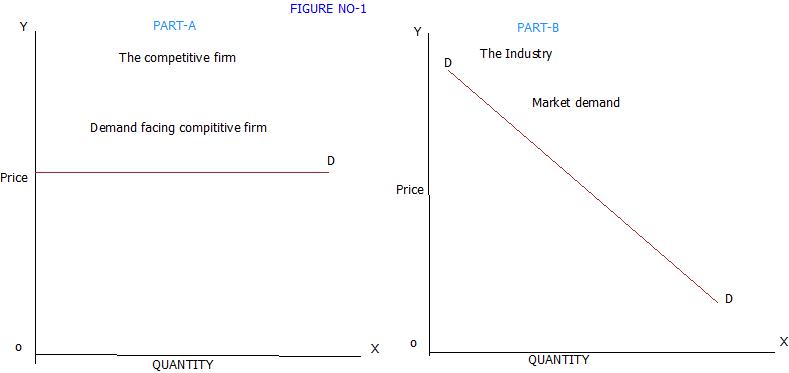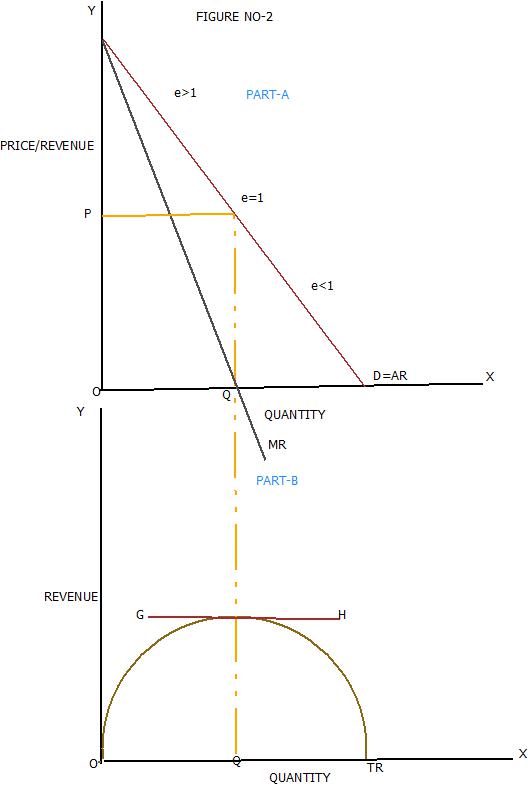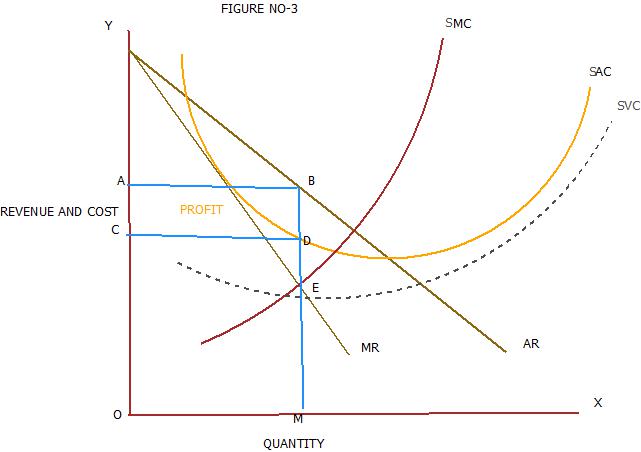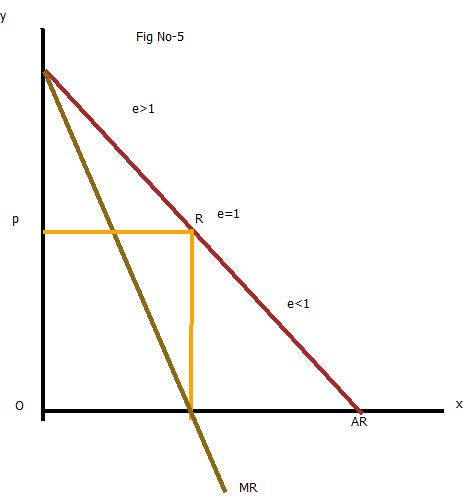MONOPOLY
MICROECONOMICS

|
MONOPOLY |

|
Introduction |
In this unit we examine how market structure influences market outcomes. Imperfect market may assume a variety of forms like monopoly, monopsony, duopsony,oligopoly and bilateral monopoly. In this chapter we study how a market controlled by just one firm –a monopoly. A study of these situation would help us in appreciating the reality around us, particularly the present status of monopoly regulation in the country. Pricing strategy plays an important role in many business decisions.
| Features of Monopoly |
- 1. Single seller –There is only one seller or firm in the market facing many buyers.
- 2. No close substitutes available – The entire market supply is controlled by a single producer in the market .there are no close substitutes for its product. Under monopoly firm and industry are identical.
- 3. Price-maker- Monopolist can change the price for his product. Monopolist can vary the price from buyer to buyer .There is a single ruling price which can be differentiated by the producer.
- 4. There is no separate concept of firm and industry- Monopolist faces downward sloping demand curve for its product .Monopolist can increase his sale by reducing price of his product.
- 5. There are entry barriers – Monopoly power to a firm with respect to natural resources, technical knowledge, exclusive ownership of raw-materials,business reputation etc may block the entry of new firms.
- 6. Profit maximization –The firm attempts to maximise his profit .Monopolist can fix the price as well as quantity output to be sold in the market to get maximum revenue from his sales proceeds
| Monopoly power |
The essence of monopoly power is the ability to alter the price of a product. In case of perfect competition many firms were producing and selling the same good, each firm has to act as a price taker .Each producer could sell all it wanted at the prevailing price .It would lose all its customers if tried to charge a higher price. Monopolist can alter the price of their output without losing all their customers .Sales volume may reduce when price increases but cannot drop to zero .In other words ,a monopolist faces a downward sloping demand curve.
If perfect competition is one extreme of the market structure, the other end is characterised by monopoly. It exists when just one firm is the sole producer of a product which has no close substitutes. Just as perfect competition is rare, in less regulated market economies.
Fig no-1 illustrates the distinction between perfectly competitive and imperfectly competitive firm .A competitive can sell its entire output at the prevailing market price. Hence each individual firm effectively confronted a horizontal demand curve explain in part A of the fig 1. You also noted earlier that firms under perfect competition do not violate the law of demand .People are not willing to buy unlimited quantities at the prevailing market rate. To induce consumers to buy more of the same product, the market price must be reduced.
Contradiction between the law of demand and the situation of the competitive firm resolved in fig no -1 .There are two relevant demand curves. One on the left hand side of the fig no-1, which appears to contradict law of demand, refers to a single competitive seller in the market. Left hand side of the figure no -1 represent entire industry of which single firm is one very small part .The industry demand curve slope downward from left to right , even though individual competitive firms able to sell their own output at the prevailing market price .
It is important for us to understand the nature of demand curve facing a monopolist .The nature of demand curve of a perfectly competitive firm is horizontal strait line ,where as it is downward sloping for the whole competitive industry. A competitive firm constitute a tiny part of the whole industry cannot influence the ruling price of the product .It is a mere quantity adjuster and has no influence over price.
| The nature of AR,MR and TR curves under monopoly |
In monopoly market situation the firm is identical to the market demand curve for the product. The difference between firms under perfect competition and monopoly is from demand side only. In case of perfectly competitive firm marginal revenue is equal to price irrespective of level of output and sales. But in monopoly the demand for the product of the firm is constitutes the total market demand of the commodity.
Table no -1
TABLE NO :1 MONOPOLIST’S DEMAND SCHEDULE ,TR AND MR
| COMBINATIONS | QUANTITY | PRICE(AR) | TOTAL REVENUE | MARGINAL REVENUE |
| A | 1 | 50 | 50 | 50 |
| B | 2 | 45 | 90 | 40 |
| C | 3 | 40 | 120 | 30 |
| D | 4 | 35 | 140 | 20 |
| E | 5 | 30 | 150 | 10 |
| F | 6 | 25 | 150 | 0 |
| G | 7 | 20 | 140 | -10 |
| H | 8 | 15 | 120 | -20 |
| I | 9 | 10 | 90 | -30 |
| J | 10 | 05 | 50 | -40 |
A competitive firm can maximize profits by producing at that rate of output where the marginal cost is equals to the price. The demand curve facing a monopolist is downward sloping .A firm must lower its price to increase the sales of his output. Similarly he can raise the price if he is prepared to sacrifice some sales. In table no 1, firm wants to increase its sales from 1 to 2 units per day and hence reducing price from 50 rupees to 45 rupees .The marginal revenue of the second unit is therefore only 40 rupees. This implies that the if the monopolist wishes to sell more and more units of his commodity ,he must progressively lower down the price.
Table -1 shows that as price decreases quantity sales increases .Consequently total revenue increases. This process continues until the price falls to 30 rupees and the demand for the same amounts to 5 units .The total revenue will be equal to150 rupees .Further reduction in the price of the goods reduces the total revenue. When price falls to 10 rupees demand increases to 10units. However the total revenue declines to 50 rupees. So long as the demand curve is downward sloping, MR will be less than price.This implies that as long as total revenue increases the marginal revenue remain positive .When it reaches its maximum level, the marginal revenue falls to zero. When total revenue falls, the marginal revenue will be negative.
Fig -2 is divided in two parts .Marginal revenue curve sloping downward lying below average revenue curve at all levels of output. At price OP the monopolist’s marginal revenue is zero. Part A of figure no-2 shows the downward sloping demand curve illustrates an inverse relationship between price and quantity demand. But profit maximising rule does not work for a monopolist .It is difficult to choose the price – quantity combination which yield him maximum possible profits. Demand curve facing the monopolist will be his average curve. Part-B of Figure -2 summarizes the calculation given in table no 1.The slope of the total revenue curve is zero which implies that the marginal revenue of the monopolist is zero.
| The relationship between AR,MR and elasticity of demand under monopoly |
The average and marginal revenue at a quantity are related to each other though elasticity.
In this connection we derive the following formula.
MR=AR(e-1/e) Where e stands for elasticity.
Since AR = Price
Therefore,MR=Price (e-1/e)
Or Price=MR (e/e-1)
The expression e-1/e will be less than unity. Hence MR will be less than price. The extent to which marginal revenue will be less than price depends upon the value of the fraction (e-1/e).
| Short -run Monopoly Equilibrium |
Short -run Monopoly Equilibrium: Marshall evolved three time period in the analysis of price output determination .A monopolist firm continuously adjust its output with respect to the current and expected sales and cost of production incurred on output .Then monopolist set his market price .Therefore monopolist generally does not distinguish between market period and short period . But the distinction is significant between short run and long run.In the short run monopolist will not be able to change his plant size . He can expand or contracts his output only by changing his variable factors.
Conditions for the short run monopoly equilibrium:
- 1. In monopoly market structure MC=MR at the point of equilibrium.
- 2. The SMC curve cuts SMR from below.
Short-run equilibrium (with profit) under monopoly :
Profit maximisation is an important objective of monopoly. Monopoly equilibrium is illustrated in Fig no 3. The monopolist will go on producing additional units of output as long as marginal revenue exceeds marginal costs .Monopolist profit will be maximum and will attain equilibrium at the level of output at which marginal revenue is equal to marginal cost.
The monopolist will never be in equilibrium at a point on demand curve at which elasticity of demand is less than one .In other words the monopolist will never set his level of output at which elasticity of demand or average revenue curve is less than one. It was derived from the relationship between AR,MR and elasticity that whenever elasticity is less than one marginal revenue is negative.
Monopoly equilibrium is given in Fig no 3 illustrates, the producer will go on producing output so long as marginal revenue exceeds marginal cost .This is because it is profitable to produce an additional unit gives more revenue than cost. In Fig.3, marginal revenue is equal to marginal cost at OM level of output. If monopolist increases his level of output beyond ON, marginal revenue will be less than marginal cost. Therefore monopolist will be incurring loss. In the above diagram equilibrium price is OA or MB. The total profit earned by monopolist is ABCD.Under monopoly the price can not be equal to marginal cost. As we know that :
Price = MR (e/e-1)
At the point of equilibrium,MR=MC
Therefore,Price =MC (e/e-1)
Since e/e-1 is more than one for a given value of elasticity, it is obvious that under monopoly:
Price>MC
The extent to which price will be greater than marginal cost will be given by the expression e/e-1.Monpoly price is therefore a function of marginal cost and elasticity of demand. The difference between average revenue and average cost in figure 3 depicts super-normal profit earned per unit of output by monopolist. The total profit will be equal to ABCD .The producer will go on producing output so long as marginal revenue exceeds marginal cost .This is because it is profitable to produce an additional unit gives more revenue than cost. In Fig.3, marginal revenue is equal to marginal cost at ON level of output. If monopolist increases his level of output beyond OM, marginal revenue will be less than marginal cost .Therefore monopolist will be incurring loss. The equilibrium price is OA or MB. The total profit earned by monopolist is ABCD.
Marginal cost under perfect competition associate prices with quantity to be produced and supplied. But in case of monopoly price is higher than marginal cost and does not associate price and quantity to be produced .Thus the marginal cost cannot function as supply curve .Therefore no monopolist firm will produce on that portion of demand curve (e<1) which gives him negative marginal revenue so also reduces his total revenue. But production of marginal unit adds to his cost. Therefore it concludes that monopolist equilibrium lie somewhere above the middle point of the average revenue curve ,where e>1.
Short-run equilibrium (with losses) under monopoly:
It is generally believed that monopolist always earn profits .In the short-run, if the demand is not sufficient monopolist can make losses. At times of recession or depression or and kind of crises demand for goods decreases and monopolist has to suffer losses .But if the losses continued for a long time then the monopolist will shut down his present business in the long run .But in the short run he will continue in his present business so long as his price is greater than the average variable cost. When losses exceed total fixed costs and the monopolist will not be able to cover his variable cost fully, the monopolist would stop production in the short-run.
Figure-4
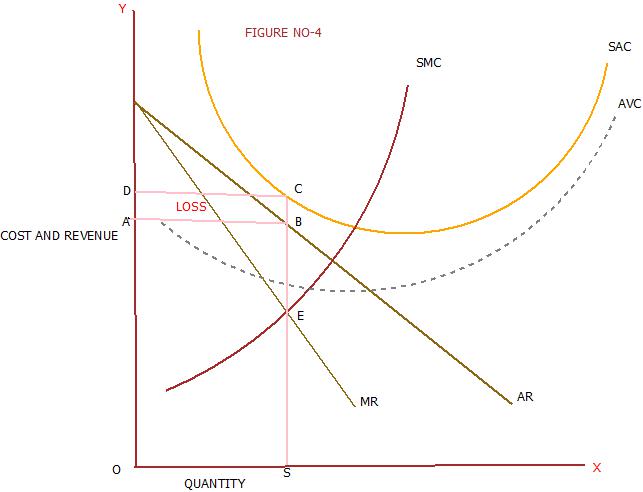
The monopolist is in equilibrium at OS level of output, where OP price is determined. This case price is greater than average cost therefore the monopolist is making losses is equal to the area of the rectangle ABCD.As price is higher than average variable cost ,the monopolist will continue his production in the short run. From the above discussion we can conclude that demand for the product plays an important role in determining whether the monopolist will get profit or make losses.
| Monopoly equilibrium in case of zero marginal cost |
We can take the case of some output where the cost of production of additional unit is zero .For instance mineral spring water or sands from the river bank, where the cost of production is either zero or is irrelevant to consider. In this case monopolist will establish equilibrium at the point where the elasticity of demand will be equal to one.This is for the simple reason that the monopolist has to adjust his output where the total revenue is maximum.
In the above diagram monopolist equilibrium is established at point E at ON level of output at which marginal revenue is zero and OP price is determined. ON quantity of output will yield maximum total revenue and beyond this marginal revenue becomes negative which means total revenue start declining. Since cost of production is zero, the whole revenue will represent profits. As at ON level of output MR is zero and corresponding to zero marginal revenue, elasticity of the demand on the average revenue curve is equal to unity. If the marginal cost is positive ,monopolist will be in equilibrium at the point where the elasticity of demand is greater than one.

|
Results |
| Number of firms | Market power | Product differentiation | Excess profits | Profit maximization condition | |
|---|---|---|---|---|---|
| Perfect Competition | Infinite | None | not existing | None | No
|
| Monopoly | One | High | not existing | Absolute (across industries) | Yes
|

|
Key Terms |
1.Single seller
2.No close substitutes available
3.Monopolist is a price-maker

|
Self-Assessment Questions (SAQs) {{{n}}} |
| {{{SAQ}}} | |
1.Discuss the main features of Monopoly.
2.Show with diagrame, how does a firm achieve equilibrium in monopoly in the short run?
3.Discuss the monopoly power of a single firm.
4."A monopolist can always make profit,be it under rising costs or falling costs or constant costs."Draw a set of three diagrams to illustrate this statement.
5.In theory ,a monopolist should make profit, but in practice some monopolists(like the State Electricity Board or some other public sector units) are often found to incur huge losses.How would you explain this situation?

|
Further Readings |
1. A.Koutsoyiannis-Modern Microeconomics
2. Stonier & Hague--Economics
3. Samulson- Principles of Economics
4.H.L. Ahjuja- Principle of Economics
| Work in progress, expect frequent changes. Help and feedback is welcome. See discussion page. |




